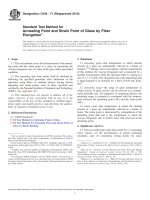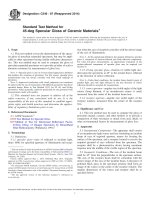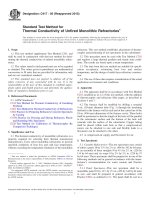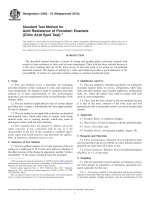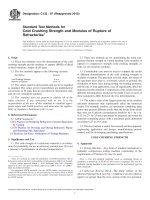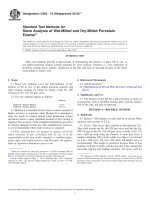Astm c 975 87 (2015)
Bạn đang xem bản rút gọn của tài liệu. Xem và tải ngay bản đầy đủ của tài liệu tại đây (48.47 KB, 2 trang )
Designation: C975 − 87 (Reapproved 2015)
Standard Practice for
Preparing Test Specimens from Basic Refractory Ramming
Products by Pressing1
This standard is issued under the fixed designation C975; the number immediately following the designation indicates the year of
original adoption or, in the case of revision, the year of last revision. A number in parentheses indicates the year of last reapproval. A
superscript epsilon (´) indicates an editorial change since the last revision or reapproval.
1. Scope
3.3 Steel Molds.
1.1 This practice covers a procedure for preparing test
specimens from basic refractory ramming products by pressing
prepared material in a mold. Specimens prepared in accordance
with this procedure are intended for use in ASTM test methods.
3.4 Oven, air circulating.
3.5 Trowel.
4. Procedure
1.2 The values stated in inch-pound units are to be regarded
as standard. The values given in parentheses are mathematical
conversions to SI units that are provided for information only
and are not considered standard.
1.3 This standard does not purport to address all of the
safety concerns, if any, associated with its use. It is the
responsibility of the user of this standard to establish appropriate safety and health practices and determine the applicability of regulatory limitations prior to use.
4.1 Store the material to be tested at 85 6 2°F (29.5 6 1°C)
for 24 h prior to testing.
4.2 Reduce the sample to the desired batch size with a
sample splitter or by quartering taking precautions to prevent
segregation. Sufficient material should be batched to provide at
least a 10 % excess over test specimen requirements.
4.3 Add the weighed, dry batch to the mixer and dry-mix at
low speed for 30 s. Continue to mix at low speed while adding
the required amount of water (see 4.3.1) within 30 s. Wet-mix
at low speed for 3 min.
4.3.1 Use the amount of water and mixing time (if different
from above) recommended by the manufacturer. The water
must be potable and at a temperature of 85 6 2°F (29.5 6
1°C). Measure the water addition to the nearest 0.1 % by
weight.
2. Significance and Use
2.1 This practice defines a procedure that ensures consistent
preparation of specimens for product testing and evaluation.
2.2 This practice can be used in the laboratories of
producers, users, and general-interest parties for research and
development or quality-control work. It is particularly useful
for interlaboratory comparisons of products, for repetitive
evaluations or comparisons of products or product quality, and
in specifying a uniform preparation practice for specimens for
acceptance testing.
4.4 Specimens of the desired size should be pressed immediately after the batch is mixed. Weigh the proper amount of
material for each specimen to the nearest 0.02 lb (10 g), and
distribute the mix uniformly in the mold using the narrow edge
of a trowel. The remainder of the batch should be covered with
a damp cloth during the pressing procedure. Press test specimens at 10 000 psi (68.95 MPa).
2.3 In using this practice it must be recognized that the
structure of laboratory-pressed specimens may differ significantly from the structure of material rammed in field applications.
3. Apparatus
4.5 Test specimens should be air-dried for 4 h, and then
dried for a minimum of 8 h at 225 6 5°F (107 6 2.5°C) in a
circulating air dryer prior to testing. Testing should be carried
out within 48 h.
3.1 Mixer, bench-type, Hobart or equivalent.
3.2 Press, mechanical or hydraulic.
1
This practice is under the jurisdiction of ASTM Committee C08 on Refractories
and is the direct responsibility of Subcommittee C08.09 on Monolithics.
Current edition approved Oct. 1, 2015. Published October 2015. Originally
approved in 1982. Last previous edition approved in 2009 as C975 – 87 (2009).
DOI: 10.1520/C0975-87R15.
5. Calculation and Report
5.1 In the report on specimen preparation, include the
percent water addition, drying time, and test specimen size.
Copyright © ASTM International, 100 Barr Harbor Drive, PO Box C700, West Conshohocken, PA 19428-2959. United States
1
C975 − 87 (2015)
ASTM International takes no position respecting the validity of any patent rights asserted in connection with any item mentioned
in this standard. Users of this standard are expressly advised that determination of the validity of any such patent rights, and the risk
of infringement of such rights, are entirely their own responsibility.
This standard is subject to revision at any time by the responsible technical committee and must be reviewed every five years and
if not revised, either reapproved or withdrawn. Your comments are invited either for revision of this standard or for additional standards
and should be addressed to ASTM International Headquarters. Your comments will receive careful consideration at a meeting of the
responsible technical committee, which you may attend. If you feel that your comments have not received a fair hearing you should
make your views known to the ASTM Committee on Standards, at the address shown below.
This standard is copyrighted by ASTM International, 100 Barr Harbor Drive, PO Box C700, West Conshohocken, PA 19428-2959,
United States. Individual reprints (single or multiple copies) of this standard may be obtained by contacting ASTM at the above
address or at 610-832-9585 (phone), 610-832-9555 (fax), or (e-mail); or through the ASTM website
(www.astm.org). Permission rights to photocopy the standard may also be secured from the Copyright Clearance Center, 222
Rosewood Drive, Danvers, MA 01923, Tel: (978) 646-2600; />
2



